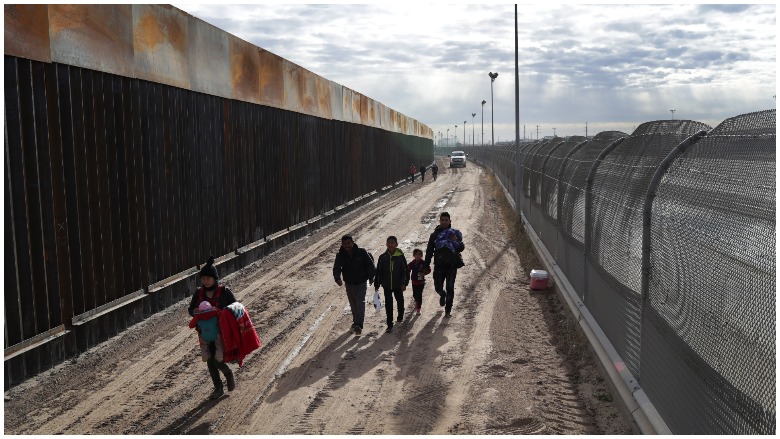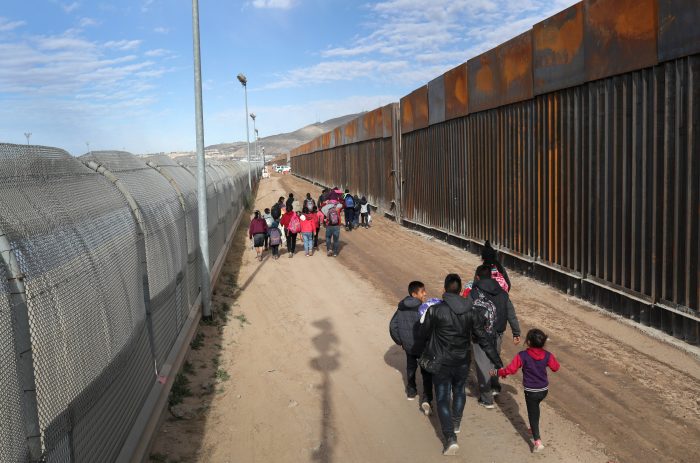
Getty Central American immigrants walk between a Bollard-style border fence, left, and the older 'legacy' fence after crossing the Rio Grande from Mexico on February 01, 2019 in El Paso, Texas.
Congress has approved a border security funding bill and sent it to the president for his signature. President Trump has indicated he would sign it and avoid another government shutdown. On February 15, the president also announced that he was declaring a national emergency to secure additional wall funding from other sources.
The bill includes $1.375 billion for 55 miles of new barriers and $1.7 billion for other border security measures. You can read more about the bill and the leadup to its passage here.
The measure allows for “bollard-style” fencing. Republican Rep. Kay Granger of Texas told the New York Times that she thought the material looked like “really heavy fences” but also thought the president would support it. The material is already in use along the border.
What is bollard-style fencing?
Here’s what you need to know.
Bollards Are Defined as Steel Posts Meant to Stop Vehicles From Passing

GettyCentral American immigrants walk between a Bollard-style border fence, right, and the older “legacy” fence after crossing the Rio Grande from Mexico on February 01, 2019 in El Paso, Texas.
President Trump originally described a wall as a concrete barrier along the southern border. He has since amended that thinking and has taken to describing the wall as “steel slats.” The bollard-style fencing, or bollard-style wall, is more in line with the “steel slat” idea.
U.S. Customs and Border Protection includes the following definition on its website: “A steel-bollard style wall provides significant impedance and denial capability. These are hollow steel beams that are filled with concrete and rebar. The space between the bollards satisfies a visibility requirement.”
The company “Long Fence,” which has been installing commercial and residential fencing since 1945, describes bollards as such: “Bollards are upright steel posts mounted in or alongside roads and parking lots to control, direct or obstruct vehicular traffic or impact.”
The magazine Popular Mechanics described bollards in 2010 as “the fence style the average person is most likely to encounter, though in a different guise: They’re the stubby, concrete-filled barriers that protect office buildings and shopping malls across the U.S. The bollard’s sole purpose is to prevent vehicles from crashing through. Wildlife, whose habitat often spans both sides of the border, can easily pass. So can people.” This description was used in an article to describe various materials used for fencing along the border in Arizona aimed at stopping undocumented immigrants.
Border Patrol: The Bollard-Style Barrier is ‘Very Much a Wall’
The existing bollard-style barrier has been described using both the terms “wall” and “fence.” The chief of the Border Patrol in El Paso, Aaron Hull, said in a news conference in April of 2018 that “this wall is going to reduce illegal entries. It’s going to help us maintain a secure border.”
At 13:12 in the video embedded above, a reporter asked about the terminology. You can hear him say, “You’ve always referred to this as a wall or fence. And now it’s a wall. How much of that has to do with trying to use the president’s terminology?”
Hull responded, “I’ve worked in the Border Patrol in four sectors and up at headquarters. I’ve heard physical barrier referred to by a lot of terms. The wall that we’re putting in place is accurately described as a wall because it’s a very serious structure. You’re talking, like you said, 18 feet, 5-foot anti-climbing plate, concrete-filled with rebar, 6 feet into the ground, another two feet of concrete underneath that. Sir, it’s very much a wall and we’re going to use it to stop illegal entries.”
The Department of Homeland Security Describes a Steel Bollard Wall as ‘Very Effective’
The Department of Homeland Security put out a news release on December 12, 2018, titled “Walls Work.” The department described building walls that were 30-feet high and said they expected to have more than 120 miles of the barrier constructed by the end of 2019. The release said that a $5 billion budget in 2019 would enable them to construct “more than 330 miles of border wall.”
Homeland Security described the barrier as a “steel bollard wall.” The department said it had been erecting the steel barrier in parts of San Diego, El Central and El Paso, described as “Border Patrol’s highest priority locations.”
Officials explained that the barrier had been “very effective.” The release mentioned a situation in early December of 2018, “when a violent mob of 1,000 people stormed our Southern border.” The department said, “there were no breaches along the newly constructed border wall areas.”
Homeland Security added in the release that walls are one part of the strategy to secure the southern border. The release stated that border security “relies on a combination of border infrastructure, technology, personnel and partnerships with law enforcement at the state, local, tribal, and federal level.”
READ NEXT: FBI: Ohio Man Threatened to Behead President Trump & His Children